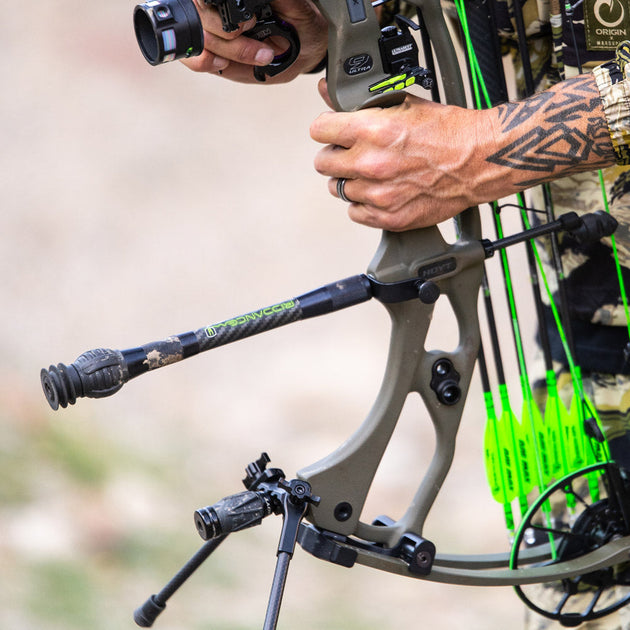Discover the most effective Bow Stabilizers for every single Archer's Demands
Discover the most effective Bow Stabilizers for every single Archer's Demands
Blog Article
Optimize Your Archery Precision With These Bow Stabilizer Techniques
One vital aspect that can substantially affect your performance is the correct use of bow stabilizers. Whether you are an experienced archer looking to fine-tune your skills or a newcomer anxious to improve your accuracy, understanding these bow stabilizer methods might be the key to hitting your mark with unmatched uniformity.
Advantages of Utilizing Bow Stabilizers
Using bow stabilizers can dramatically improve an archer's precision and overall efficiency by reducing bow torque and resonance. Additionally, bow stabilizers moisten resonance, which not just improves the convenience of capturing however additionally avoids the bow from leaping upon launch, thus helping in keeping proper objective.
Furthermore, bow stabilizers can aid in holding the bow consistent, specifically during gusty problems or when firing from longer distances. The added weight at the front of the bow offers stability and equilibrium, permitting the archer to focus on aiming without the diversion of bow activity. On the whole, the benefits of using bow stabilizers prolong beyond just precision, improving the archer's experience and efficiency in numerous shooting circumstances.
Choosing the Right Bow Stabilizer
Picking the ideal bow stabilizer is critical for optimizing your archery tools and boosting shooting efficiency. Much heavier stabilizers can assist decrease bow torque and absorb even more resonance, leading to a steadier objective.

Lastly, think about the layout of the stabilizer. Some stabilizers include flexible weights or dampeners that permit you to customize the equilibrium and feeling of your bow. Ultimately, selecting the ideal bow stabilizer involves finding a balance in between weight, layout, size, and product to improve your capturing precision and total efficiency.
Proper Setup Methods
To make certain optimum performance and safety in archery, grasping appropriate setup methods for your bow stabilizer is important. The first step in installing a bow stabilizer is to identify the appropriate placement on your bow. A lot of stabilizers are affixed to the front of the riser, listed below the hold, to assist counterbalance the weight of devices such as views and quivers. Ensure that the stabilizer is not conflicting with various other elements or impeding your capturing type.
Next, firmly connect the stabilizer to the bow using the ideal installing hardware. Some stabilizers come with adjustable weights that can be added or removed to fine-tune the equilibrium of your bow.

Adjusting Stabilizer Weight and Size
After guaranteeing the proper installment of your bow stabilizer, find here the next action includes changing the weight and length to enhance its efficiency in improving archery precision. The weight of the stabilizer plays an essential function in reducing bow activity during the shot cycle. Adding weight to the stabilizer can help boost and wet vibrations stability, bring about even more accurate and constant shots. On the other hand, minimizing the weight can boost ability to move, news which is valuable for scenarios requiring quick target acquisition.
When it comes to stabilizer size, discovering the best balance is key. A longer stabilizer can give better stability by increasing the range between the bow and the weight at the end of the stabilizer. This included range improves the stabilizing result, particularly in windy problems or when contending longer distances. Alternatively, a much shorter stabilizer provides more ability to move and might be chosen by archers who value dexterity and quick activities throughout shooting.
Advanced Stabilizer Tuning Tips
Attaining ideal bow security and precision in archery requires a nuanced method to innovative stabilizer tuning. Advanced stabilizer adjusting involves fine-tuning numerous components to improve the bow's equilibrium, minimize resonance, and improve total accuracy. One crucial technique is to trying out different stabilizer arrangements, including back-bar and side-bar setups, to discover the perfect equilibrium in between stability and maneuverability for your capturing style. bow stabilizer. Furthermore, adjusting the angle and positioning of the stabilizer can have a considerable influence on how the bow responds upon launch.
Another important facet of innovative stabilizer adjusting is optimizing the damping properties of the stabilizer system. This can be attained by incorporating additional dampening accessories such as rubber dampeners or harmonic stabilizers to additionally lower resonance and sound. Furthermore, exploring different materials for the stabilizer building and construction, such as carbon fiber or light weight aluminum, can additionally affect the bow's performance by modifying its weight distribution and stiffness. By carefully tweak these sophisticated stabilizer aspects, archers can optimize their precision and link uniformity on the array or in competitors.
Verdict
In conclusion, optimizing archery precision can be achieved via the proper choice, installment, and adjustment of bow stabilizers. Generally, integrating bow stabilizers right into archery method can lead to better efficiency and increased precision.
Making use of bow stabilizers can dramatically boost an archer's precision and total efficiency by reducing bow torque and vibration. Longer stabilizers offer greater security and balance, particularly for long-distance capturing, while shorter stabilizers supply more convenience and are easier to maneuver in tight spaces (bow stabilizer). Carbon fiber stabilizers are lightweight and long lasting, while light weight aluminum stabilizers are robust and offer outstanding resonance wetting
A longer stabilizer can supply greater stability by raising the distance between the bow and the weight at the end of the stabilizer.One more vital facet of advanced stabilizer tuning is optimizing the damping properties of the stabilizer system.
Report this page